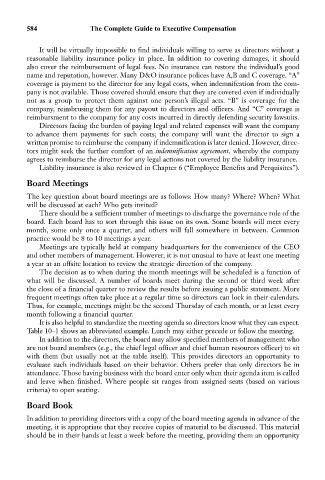Page 598 - Bruce Ellig - The Complete Guide to Executive Compensation (2007)
P. 598
584 The Complete Guide to Executive Compensation
It will be virtually impossible to find individuals willing to serve as directors without a
reasonable liability insurance policy in place. In addition to covering damages, it should
also cover the reimbursement of legal fees. No insurance can restore the individual’s good
name and reputation, however. Many D&O insurance polices have A,B and C coverage. “A”
coverage is payment to the director for any legal costs, when indemnifcation from the com-
pany is not available. Those covered should ensure that they are covered even if individually
not as a group to protect them against one person’s illegal acts. “B” is coverage for the
company, reimbrusing them for any payout to directors and officers. And “C” coverage is
reimbursment to the company for any costs incurred in directly defending security lawsuits.
Directors facing the burden of paying legal and related expenses will want the company
to advance them payments for such costs; the company will want the director to sign a
written promise to reimburse the company if indemnification is later denied. However, direc-
tors might seek the further comfort of an indemnification agreement, whereby the company
agrees to reimburse the director for any legal actions not covered by the liability insurance.
Liability insurance is also reviewed in Chapter 6 (“Employee Benefits and Perquisites”).
Board Meetings
The key question about board meetings are as follows: How many? Where? When? What
will be discussed at each? Who gets invited?
There should be a sufficient number of meetings to discharge the governance role of the
board. Each board has to sort through this issue on its own. Some boards will meet every
month, some only once a quarter, and others will fall somewhere in between. Common
practice would be 8 to 10 meetings a year.
Meetings are typically held at company headquarters for the convenience of the CEO
and other members of management. However, it is not unusual to have at least one meeting
a year at an offsite location to review the strategic direction of the company.
The decision as to when during the month meetings will be scheduled is a function of
what will be discussed. A number of boards meet during the second or third week after
the close of a financial quarter to review the results before issuing a public statement. More
frequent meetings often take place at a regular time so directors can lock in their calendars.
Thus, for example, meetings might be the second Thursday of each month, or at least every
month following a financial quarter.
It is also helpful to standardize the meeting agenda so directors know what they can expect.
Table 10–1 shows an abbreviated example. Lunch may either precede or follow the meeting.
In addition to the directors, the board may allow specified members of management who
are not board members (e.g., the chief legal officer and chief human resources officer) to sit
with them (but usually not at the table itself). This provides directors an opportunity to
evaluate such individuals based on their behavior. Others prefer that only directors be in
attendance. Those having business with the board enter only when their agenda item is called
and leave when finished. Where people sit ranges from assigned seats (based on various
criteria) to open seating.
Board Book
In addition to providing directors with a copy of the board meeting agenda in advance of the
meeting, it is appropriate that they receive copies of material to be discussed. This material
should be in their hands at least a week before the meeting, providing them an opportunity

